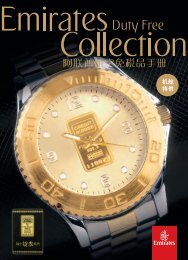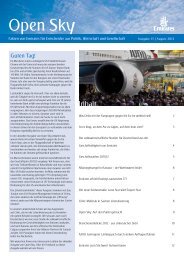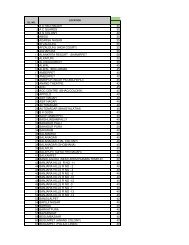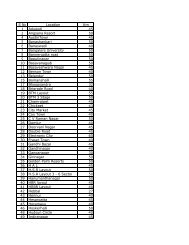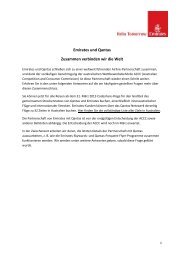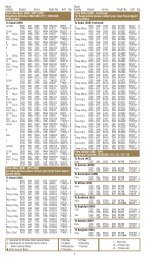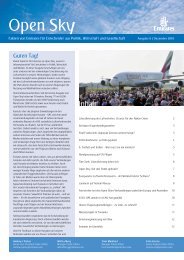Annual Report 2008-2009 - Emirates.com
Annual Report 2008-2009 - Emirates.com
Annual Report 2008-2009 - Emirates.com
Create successful ePaper yourself
Turn your PDF publications into a flip-book with our unique Google optimized e-Paper software.
2. Summary of significant accounting policies (continued)<br />
The purchase method of accounting is used to account for acquisition of subsidiaries. The cost of an acquisition is measured as the fair<br />
value of assets given and liabilities incurred or assumed at the date of exchange, plus costs directly attributable to the acquisition.<br />
Identifiable assets including intangible assets acquired, liabilities and contingent liabilities incurred or assumed in a business <strong>com</strong>bination<br />
are measured at their fair values at the acquisition date.<br />
Transactions with minority interests are treated as transactions with external parties. Disposals to minority interests results in gains and<br />
losses that are recorded in the consolidated in<strong>com</strong>e statement. Purchases from minority interests results in goodwill, being the difference<br />
between any consideration paid and the relevant share acquired of the carrying value of the net assets of the subsidiary.<br />
Associated <strong>com</strong>panies are those entities in which <strong>Emirates</strong> has significant influence but not control, generally ac<strong>com</strong>panying a<br />
shareholding between 20% and 50% of voting rights. Investments in associated <strong>com</strong>panies are accounted for by applying the equity<br />
method and include goodwill (net of accumulated impairment loss, if any) identified on acquisition. Equity accounting is discontinued from<br />
the date significant influence ceases, and the investment is then accounted in accordance with IAS 39 provided the associate does not<br />
be<strong>com</strong>e a subsidiary or joint venture. The carrying value of the investment at the date it ceases to be an associate is regarded as its cost<br />
on initial measurement as a financial asset in accordance with IAS 39.<br />
Joint ventures are contractual arrangements which establish joint control. Investments in jointly controlled entities are accounted for by<br />
applying the equity method.<br />
Unrealised gains and losses arising on transactions between <strong>Emirates</strong> and its associates and joint ventures are eliminated to the extent of<br />
<strong>Emirates</strong>’ interest.<br />
Accounting policies of subsidiaries, associated <strong>com</strong>panies and joint ventures have been changed where necessary to ensure consistency<br />
with <strong>Emirates</strong>’ accounting policies.<br />
Revenue<br />
Passenger and cargo (which includes courier and mail) sales are recognised as revenue when the transportation is provided. Tickets sold<br />
but unused are held in the consolidated balance sheet under current liabilities as passenger and cargo sales in advance. Unused tickets<br />
are recognised as revenue based on the terms and conditions of the tickets and historical trends.<br />
Revenue from sale of goods is recognised when risks and rewards of ownership are transferred to the customer and are stated net of<br />
discounts and returns. Other revenue is recognised net of discounts when services are rendered.<br />
Interest in<strong>com</strong>e is recognised on a time proportion basis using the effective interest method.<br />
Liquidated damages<br />
In<strong>com</strong>e from claims for liquidated damages is recognised in the consolidated in<strong>com</strong>e statement when a contractual entitlement exists,<br />
amounts can be reliably measured and receipt is virtually certain. When such claims do not relate to a <strong>com</strong>pensation for loss of in<strong>com</strong>e or<br />
towards incremental operating costs, the amounts are taken to the consolidated balance sheet and recorded as a reduction in the cost<br />
of the related asset.<br />
Foreign currency translation<br />
Foreign currency transactions are translated into UAE Dirhams (AED), the functional currency, at exchange rates approximating those<br />
ruling on the transaction dates. Monetary assets and liabilities denominated in foreign currencies are translated into UAE Dirhams at the<br />
exchange rates ruling on the balance sheet date. The resultant foreign exchange gains and losses, other than those on qualifying cash<br />
flow hedges deferred in equity, are recognised in the consolidated in<strong>com</strong>e statement.<br />
Translation differences on non-monetary items classified as available-for-sale financial assets are included in a fair value reserve in equity.<br />
In<strong>com</strong>e and cash flow statements of subsidiaries are translated into UAE Dirhams at average exchange rates for the year that<br />
approximate the cumulative effect of rates prevailing on the transaction dates and their assets and liabilities are translated at the<br />
exchange rates ruling on the balance sheet date. The resulting exchange differences are recognised in the translation reserve in equity.<br />
Share of results in associated <strong>com</strong>panies and joint ventures are translated into UAE Dirhams at average exchange rates for the year.<br />
Translation differences relating to investments in subsidiaries, associated <strong>com</strong>panies and joint ventures are classified as a translation<br />
reserve in equity. When the investment in subsidiaries, associated <strong>com</strong>panies or joint ventures are disposed of, the translation differences<br />
held in equity are recognised in the consolidated in<strong>com</strong>e statement as part of the gain or loss on sale.<br />
077





